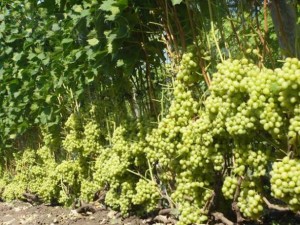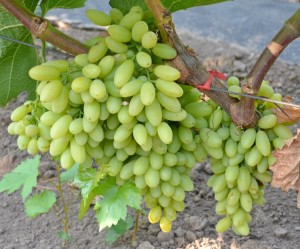Kishmish century - grapes "with raisins"
The raisin grape variety Century, or its other common name, Centenel Seedlis, was developed in the 1980s in the United States. Nowadays, it enjoys wide popularity not only among professional winegrowers, but also among amateurs. Deserves a positive review of both.
Content
Description
The Century grape is a seedless variety. The ripening period is average, from the beginning of the growing season 120-125 days. Very vigorous bushes that are grown on rooted cuttings, while grafted raisins are more compact. A detailed description of the plant can be found in the specialized literature.
The flower is bisexual, well pollinated. The bunches are large, numerous, weighing 850-1200 g. The berries are medium-large, weighing 7-9 g, elongated oval, light yellow or yellow-green in color, do not crack or crumble when overripe. The bunches can hang on the bush until the very frost, becoming more sugary and acquiring an amber-yellow hue. Not susceptible to peas. The pulp is homogeneous, juicy, very sweet and slightly crunchy, with a pleasant harmonious taste and nutmeg aroma. The rudiments are completely absent. The skin is thin but firm, edible, crispy, smooth. The sugar content of the berries reaches 15-16%, the acidity is 4-6g / l.

Advantages of the variety
High and regular yield is the greatest advantage of this variety. Its large clusters, with proper care and annual fertilization, can reach 1100-1250 g. They have a good presentation, high transportability, and berries with high palatability are sweet with a slight acidity and moderate nutmeg. In addition, they do not crumble when overripe and are not susceptible to sunburn. However, if during the ripening period they are in direct sunlight for a long time, small brown spots may appear.
Centenel sidlis has a high resistance to many diseases, such as mildew, powdery mildew, and gray mold lesions have not been observed. High survival rate of cuttings.

It is the raisin sultish that is best suited for drying with raisins. Its clusters and berries are very large in size, do not peas, do not crack from an abundance of precipitation and do not burn in the sun. Also, this variety is highly frost-resistant, the buds in the eyes can withstand temperatures down to -23-25C. An adult bush does not need winter shelter, however, young seedlings should be closed for wintering within 3-6 years after planting.
Agricultural technology to increase the yield
A significant increase in yield in this variety occurs after long pruning, since the fruitfulness of the eyes, which are located at the base of the shoots, is relatively low. The optimal load of the eyes on the plant is no more than 40-45.

Kishmish Century does not need to be normalized by inflorescences, since the bush copes with the load easily. However, in order to obtain larger berries, it is necessary to remove part of the young bunch after flowering and ringing, and thin out the berries in those left. The use of gibberellin is not recommended.
Video "Kishmish Century - the best grapes for raisins"
This video shows how ripe bunches of grapes of this variety look like, what size the berries can reach with proper care.
